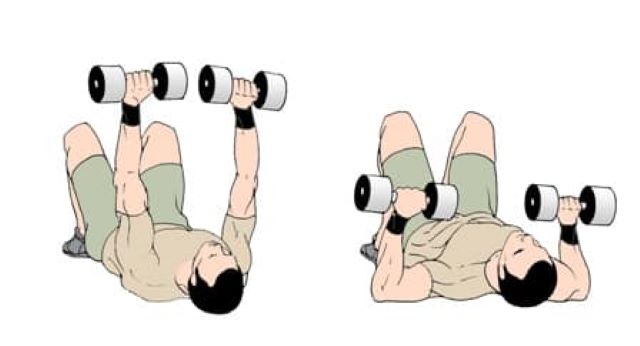Dumbbell Floor Press: Benefits, How to Do & Muscles Worked
The dumbbell floor press is an underrated yet highly effective chest press variation that can build strength in your chest, shoulders, and triceps without putting undue stress on your joints.
If traditional chest presses often leave your shoulders feeling sore or strained, the dumbbell floor press might be the perfect alternative.
Having battled shoulder issues for nearly a decade, I know firsthand how crucial it is to find chest and shoulder exercises that prioritize joint health while still helping you build muscle and get stronger.
The dumbbell floor press exercise not only targets your chest but also strengthens your triceps and shoulders, all while limiting the range of motion to protect your shoulders from unnecessary strain.
In this guide, I’ll explain the benefits of the dumbbell floor press, demonstrate proper form, and show you some variations to keep your routine challenging.
Let’s explore how this awesome movement can help you build muscle and strength effectively!
What is the Dumbbell Floor Press?
The dumbbell floor press is a strength-training exercise targeting the chest, shoulders, and triceps. It is performed while lying on the floor using dumbbells and is a variation of the traditional bench press exercise.
This movement is particularly effective for individuals who want to build upper body strength while reducing stress on the shoulders and improving lockout strength for pressing movements.
DB Floor Press Muscles Worked
The dumbbell floor press is a compound pressing movement that engages several upper-body muscle groups simultaneously.
It emphasizes horizontal pressing strength while minimizing joint stress, making it ideal for both performance and longevity.
Here’s a breakdown of the primary muscles worked during the dumbbell floor press:
Pectoralis Major (Clavicular and Sternal Heads)
The pectoralis major is the prime mover in the floor press, especially the sternal head. This muscle generates the majority of horizontal adduction force, helping to drive the dumbbells away from the body during the concentric phase.
Because the floor limits the stretch at the bottom, the emphasis remains on mid-to-end range pressing strength.
Triceps Brachii (All Three Heads)
The triceps are heavily involved, particularly in the lockout portion of the lift.
As elbow extensors, all three heads of the triceps brachii (long, lateral, and medial) contribute to pushing the dumbbells upward, especially when shoulder flexion is limited.
Anterior Deltoids
The front portion of the deltoid assists in shoulder flexion and stabilization during the press.
While the shortened range of motion reduces stress compared to a full bench press, the anterior deltoids remain active in controlling and stabilizing the weight throughout the movement.
Scapular Stabilizers (Serratus Anterior, Rhomboids, Trapezius)
Although the floor restricts scapular mobility, these muscles contribute to overall shoulder girdle stability during the press. They help maintain proper joint alignment and prevent compensatory movement patterns, especially as the load increases.
How to Do the Dumbbell Floor Press
Proper form is essential for maximizing the benefits of the dumbbell floor press while minimizing injury risk.
By lying on the floor, you limit the range of motion, which reduces shoulder strain and focuses on pressing power.
Here is how to do the DB floor press:
- Set Up: Lie flat on the floor with your knees bent and feet firmly planted. Hold a dumbbell in each hand, with your palms facing each other, and position the dumbbells over your chest.
- Position the Weights: Start with the dumbbells resting on your ribcage, keeping your elbows at about a 45-degree angle from your body to protect your shoulders.
- Press Up: Engage your chest and triceps to press the dumbbells upward toward the ceiling, extending your arms fully at the top of the movement.
- Lower with Control: Slowly lower the dumbbells back to your chest until your upper arms gently touch the floor, keeping tension in your muscles throughout the movement.
- Repeat: Continue pressing and lowering for the desired number of reps, focusing on controlled movements and proper alignment to avoid injury.
Top 5 Dumbbell Floor Press Benefits
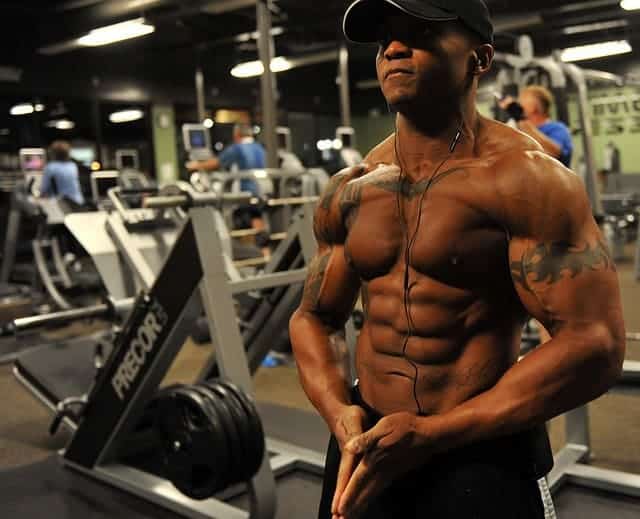
The dumbbell floor press is a powerful, often overlooked exercise that offers numerous advantages for building upper-body strength and protecting your joints.
Here are five key benefits of incorporating the dumbbell floor press into your routine:
Safe & Effective for Shoulder Health
For those with a history of shoulder issues, finding a safe pressing exercise can be challenging. The dumbbell floor press is ideal because it limits the range of motion, preventing your elbows from dipping below your torso and reducing strain on your shoulder joints.
This shortened range of motion minimizes stress while still allowing you to develop strength in your chest, shoulders, and triceps.
Additionally, the neutral grip used in the floor press mimics the shoulder’s natural movement, further reducing strain and improving comfort.
Unlike exercises like the barbell bench press, which can aggravate shoulder issues, the dumbbell floor press allows you to train safely while decompressing the shoulder joint, helping strengthen and stabilize it over time.
In fact, research analyzing biomechanical loading during 21 different barbell bench press variations found that wider grips and certain scapular positions significantly increased compression and shear forces in the glenohumeral and acromioclavicular joints, raising the risk of injuries like distal clavicular osteolysis and rotator cuff strain (Noteboom et al., 2024).
Because the dumbbell floor press uses a neutral grip and restricts shoulder abduction, it minimizes these problematic force vectors and reduces mechanical stress on the shoulder joint complex.
Builds Aesthetic Chest Muscles
If you’re aiming to build a more defined and powerful chest, the dumbbell floor press is a highly effective tool. It directly targets the pectoral muscles, helping you build mass and definition.
Whether your goal is a more toned chest or a bulkier upper body, this exercise engages the chest muscles to enhance both strength and aesthetics.
Over time, you’ll notice a more sculpted and muscular chest that complements other pressing movements in your routine.
Targeted Triceps Strength & Muscle Mass Development
The dumbbell floor press is often regarded as one of the best exercises for developing tricep strength and size. By limiting the range of motion, the exercise places a greater emphasis on the triceps, isolating them to a greater extent than traditional presses.
This makes it a highly effective movement for building strong, defined triceps while simultaneously working the chest and shoulders.
Compared to isolation exercises like pushdowns, the dumbbell floor press allows you to target multiple muscle groups at once, giving you the opportunity to build bigger triceps more efficiently. I
ncorporating this exercise into your routine can help you see faster progress with your arm development.
Improves Bench Press Strength
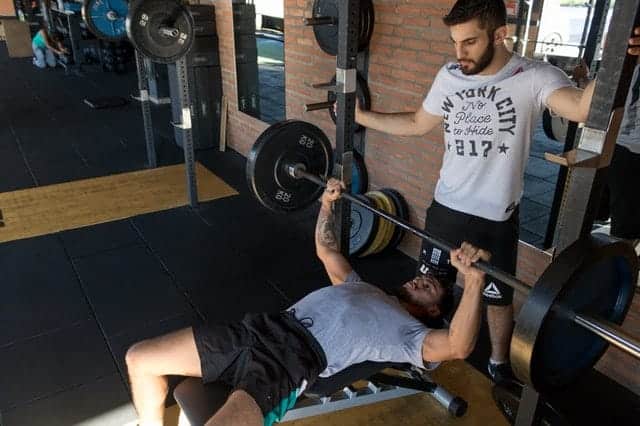
The dumbbell floor press is not only a great exercise for shoulder health but also an excellent accessory movement for improving your overall bench press strength.
By performing the floor press, you engage the same muscles used in the bench press but with greater emphasis on control and stability.
This exercise removes the ability to use momentum or “cheat” the lift, forcing your chest, triceps, and shoulders to work harder.
As a result, it enhances your form, technique, and muscle activation, leading to significant improvements when you return to traditional bench pressing.
As I’ve learned over the years, incorporating the dumbbell floor press into your bench press program can help you break through plateaus and lift more weight!
Minimal Back Strain While Pressing
One of the biggest advantages of the dumbbell floor press is its ability to minimize back strain, particularly when compared to the barbell bench press.
Since your back remains in contact with the floor throughout the movement, there’s no risk of hyperextending the lumbar spine or placing excessive stress on the lower back.
This makes it a safer alternative for those prone to back issues or individuals lifting heavier weights.
In addition, the floor press eliminates the temptation to arch your back or use momentum, ensuring you engage the correct muscles and maintain proper form.
By reducing back strain and promoting safe movement, the dumbbell floor press allows you to build upper-body strength without compromising your spine.
DB Floor Press Variations
The dumbbell floor press is a versatile exercise, and incorporating different variations can help target various muscle groups, improve strength imbalances, and add new challenges to your routine.
Each variation brings unique benefits, enhancing overall upper-body strength, stability, and control.
By incorporating these variations of the dumbbell floor press into your routine, you can target different muscle groups, build strength, improve stability, and prevent plateauing in your upper-body workouts.
Here’s a breakdown of some effective dumbbell floor press variations:
Neutral-Grip DB Floor Press
Switching to a neutral grip (palms facing each other) is a simple DB floor press variation that can reduce strain on the shoulders and provide a more natural pressing movement.
How to Perform:
- Lie on your back with your knees bent and feet on the floor.
- Hold the dumbbells with your palms facing each other (neutral grip).
- Lower the dumbbells toward your chest, keeping your elbows tucked closer to your body.
- Press the weights back up, focusing on chest and tricep contraction.
Benefits: This variation reduces stress on the shoulder joints, making it ideal for individuals with shoulder discomfort. It also emphasizes tricep activation while still working the chest.
Single-Arm Dumbbell Floor Press
The single-arm dumbbell floor press focuses on unilateral strength, improving muscle imbalances, core stability, and shoulder control.
How to Perform:
- Lie on your back with knees bent and feet flat on the floor.
- Hold a dumbbell in one hand, extending the arm straight toward the ceiling.
- Slowly lower the dumbbell toward your chest, keeping the opposite arm extended or resting on the floor for stability.
- Press the weight back up, maintaining control. After completing the set, switch to the other arm.
Benefits: This variation enhances unilateral strength, targeting each side of the body independently to correct imbalances. It also engages your core more, as your body works harder to stabilize during the single-arm press.
Glute Bridge DB Floor Press
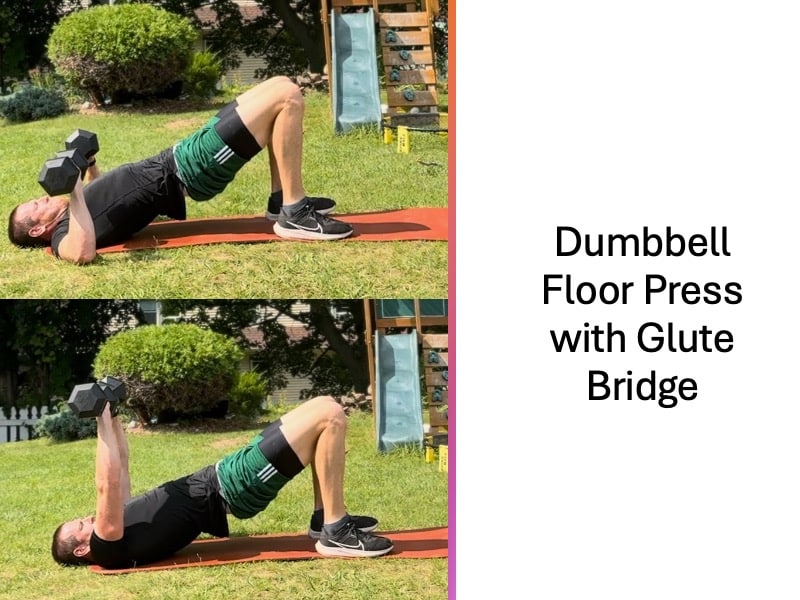
Adding a glute bridge to the dumbbell floor press increases core engagement and activates the lower body while you press.
How to Perform:
- Lie on your back with your knees bent and feet flat on the floor.
- Lift your hips off the floor to form a glute bridge, squeezing your glutes at the top.
- With dumbbells in each hand, perform a traditional dumbbell floor press while maintaining the bridge position.
- Lower the dumbbells back down while keeping your hips elevated, and repeat for the desired reps.
Benefits: This variation engages your glutes and core, improving overall stability while still targeting your chest and triceps. It also helps improve hip mobility and strength.
Single-Arm Single-Leg Glute Bridge Floor Press
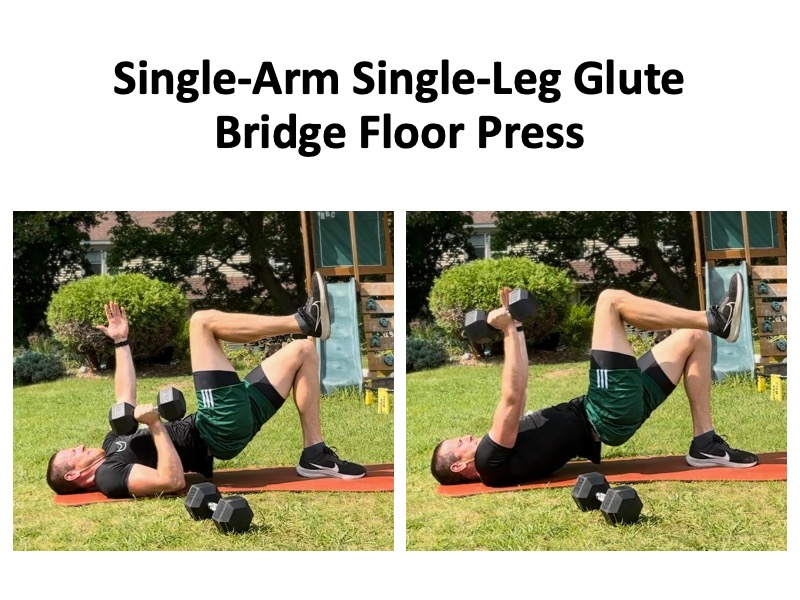
The single-arm single-leg glute bridge floor press is a high-level variation of the dumbbell floor press that targets your chest, triceps, shoulders, glutes, core, and even your hamstrings.
It’s an advanced full-body movement that reinforces unilateral strength, balance, and neuromuscular coordination.
How to Perform:
- Lie on your back with knees bent and feet flat on the floor.
- Hold a dumbbell in your right hand and extend your right leg straight out.
- Drive your left foot into the floor to lift into a single-leg glute bridge, keeping your hips high.
- With your core engaged and hips stable, press the dumbbell upward with your right hand.
- Slowly lower the dumbbell until your elbow lightly taps the floor, then press it back up.
- Complete all reps on one side before switching arms and legs.
Benefits: This variation amplifies the instability and neuromuscular demand of the traditional DB floor press, making it an excellent tool for athletes and advanced lifters. It promotes functional strength by integrating upper-body pressing with posterior chain activation and anti-rotational core engagement. Research from the Strength & Conditioning Journal has noted that the single-leg glute bridge is one of the best exercises for activating the posterior hip musculature.
The single-arm single-leg glute bridge floor press also helps correct muscle imbalances and improves total-body coordination, which is vital for anyone returning from injury or looking to prevent asymmetries that can lead to compensation patterns.
Paused Dumbbell Floor Press
Adding a pause at the bottom of the movement increases time under tension, helping to build more muscle and strength.
How to Perform:
- Set up in the standard floor press position with dumbbells in each hand.
- Slowly lower the weights until your elbows gently touch the floor.
- Pause for 2-3 seconds at the bottom, maintaining tension in your chest and triceps.
- Press the weights back up explosively and repeat.
Benefits: The paused dumbbell floor press increases time under tension and eliminates momentum, forcing your chest and triceps to generate more force from a dead stop. This variation strengthens the bottom portion of the lift, improves control, and enhances the mind-muscle connection for more effective muscle activation and growth.
Hollow-Hold Dumbbell Floor Press
Adding an isometric hollow hold to your floor press is an excellent way to improve muscular endurance and control, making the exercise more challenging and effective.
How to Perform:
- Begin in the standard floor press position, holding dumbbells in each hand.
- Lower the dumbbells until your upper arms touch the floor, keeping your elbows at a 45-degree angle.
- Pause and hold this position for 3-5 seconds, ensuring constant tension in your chest and triceps.
- Press the weights back up, then repeat for the desired number of repetitions.
Benefits: The isometric hold variation improves muscle endurance by increasing time under tension, especially at the bottom portion of the lift, where many lifters struggle. It also helps develop greater control over the movement and enhances the mind-muscle connection, allowing for more effective muscle activation.
Final Thoughts: Is the DB Floor Press a Good Exercise?
The dumbbell floor press is one of my top choices for upper body pressing exercises, and it is easily one of the best dumbbell chest exercises due to its combination of safety, effectiveness, and joint-friendly benefits.
It not only helps you build strength but also supports long-term joint health, making it ideal for anyone looking to stay strong and injury-free.
With its ability to target the chest, triceps, and shoulders, the dumbbell floor press offers numerous benefits, whether you’re aiming to increase muscle mass, improve pressing power, or protect your shoulders from strain.
It’s an excellent option for both beginners and experienced lifters, offering a versatile and accessible way to achieve your fitness goals.
By incorporating the dumbbell floor press into your routine, you can effectively build aesthetic chest muscles and strong triceps while reducing the risk of shoulder injury thanks to its limited range of motion and reduced stress on the joints.
Additionally, using variations will help you continually challenge your muscles and keep your workouts fresh.
If you’re looking to improve upper body strength, enhance shoulder health, and achieve greater muscle definition, the dumbbell floor press is a must-have in your training program.
Give it a try, and experience the benefits firsthand!

